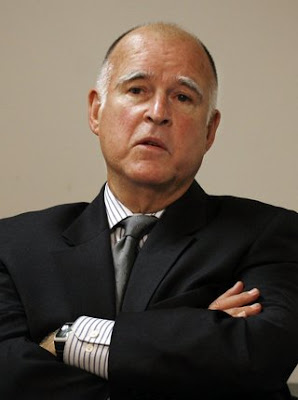In my
previous post on this subject, I tried to give a sense of how vast and difficult solving our deficit problem has become. To recap, even with draconian measures, closing the gap to 2.2% of GDP is the best that the co-chairs of the deficit commission can come up with. Putting it into family budget terms, it is like having a family income of $100,000, spending $150,000 and funding the difference with a line of credit on which you already owe $575,000. Except it's even worse, because that only includes the debt that is admitted to, other unfunded liabilities might put your future liabilities closer to $4,500,000.
Clearly drastic action is needed, but it will not be enough. As the graph below shows, the gap is monstrous. What is to be done?
It seems obvious to me that trying to increase tax receipts by raising the tax rate that each individual pays is self defeating. This is because those taxes become a drag on economic growth, and because people are incredibly ingenious at avoiding them. KT has often blogged on the need to avoid debt in financing the government, and I agree. But that need not imply that raising marginal tax rates is a particularly good way of doing so. Further, we have seen an historical trend where federal income tax receipts have been unable to break the 20% of GDP barrier, regardless of the marginal rate structure. I previously discussed
Hauer's Law last June and why increased tax rates are useless.

But the need for additional receipts can not be denied. This is why I believe that aggressive action is needed to grow the economy and the work force. Lest the reader think that I am suggesting that growth alone will pull us out of this crisis, I am not. The recommendations of the deficit commission co-chairs or something like them will also be needed. The problem has grown so large that growth alone won't solve it. But it is also so large that it is unlikely that the cuts proposed will not solve it either.
In broad brush, the federal budget requires many more people to contribute to receipts. That means that work force participation must rise dramatically from where it is today. By work force participation, we must mean in the legitimate work force, because that is what generates the revenue. Getting Americans back to work is key, but so is increasing the total size of the work force. Look at this graph from
economicpopulist.org
We are on a scary trend line that is causing federal receipts to fall. Is part of the trend demographic? In other words, is an aging U.S population causing the labor force participation rate to fall? Since those 65 and over have only a 15% chance of being employed, this sound plausible.
It seems likely that the only way to bring in new receipts to the federal government to close the deficit is to bring participants into the work force. Where should they come from?
The Unemployed. This is the most pressing need. The official unemployment rate is at 9.6%, but this vastly understates how bad the problem is.
economicpopulist.org says it best:
U6, defined as total unemployed, plus all persons marginally attached to the labor force, plus total employed part time for economic reasons, as a percent of the civilian labor force plus all persons marginally attached to the labor force, (table A.15), was 17.0%, a -0.1% decrease from last month. This number is obscene.
Getting these people back to work has to be the most important task. However, as Sharon Angle pointed out, government can not directly create the needed jobs, but has to get out of the way. Government can promote business by the consistent application of the rule of law and protection of property rights. Here are some things to aid in job creation.
- Uncertainty over the effects of Obamacare and other new regulation. A moratorium on new regulation for at least four years is needed.
- The housing market was not allowed to hit bottom. Only when prices are low enough to attract investors will new money pour into the market. I have seen this locally, where prices are not low enough for me to want to invest. Prices are still sitting at well over 20 times rent. Bust up Freddie and Fannie and let housing prices fall. With new investors in the market, then home improvement will start helping the economy.
- Stop rattling the markets with inflation fears through quantitative easing. I don't agree with the abolish the fed movement, but if they keep this up, I might change my mind. The fed should be most interested in a stable money supply, which will help businesses plan. Drudge links to a supposedly secret Walmart study that inflation is already here.
- Simplify the tax code or better yet, abolish the income tax and replace it with a value added tax (having both is unacceptable, however.) The efficiency of the tax code is relevant to economic growth, because it allows people and business to plan their economic activity in a non-distorted manner. Further, the more complex the tax code the more chicanery and bribery accrue to those getting the tax breaks. It is no coincidence that Reagan and Rostenkowski's success in simplifying the tax code and reducing rates resulted in one of the great uninterrupted economic expansions since World War II.
- Repeal Obamacare since it is responsible for both new complexity in the tax code and absurd amount of new regulation.
Those over 65 currently not working. It may seem cruel, and I am not advocating using force, but many of those over 65 are still able to work. Note the trends in this graph:

Labor force participation is already on the rise for those over 65. We need to look at policies that discourage that trend. For example, we tax social security benefits based on earnings of those already receiving social security. This discourages work by the elderly. Wouldn't we be better off if they were working. Raising the retirement age is a good idea, but will take significant time before that has any impact.
Immigrants. Here is the sticky wicket. First, illegal immigrants mostly participate in the labor force, however, only two-thirds of them pay social security taxes according to the only
source I could find on this subject. While the article was emphasizing the two-thirds who do pay, I am concerned about adding 4-5 million people to the roles who do not.
But right now, we can't solve this problem, because we will undermine the rule of law through an amnesty. The American people deserve a secure border. But the secure border can also allow us to have the discussion needed about the role of immigrants. Those who are here illegally should not be granted citizenship, that would reward their illegal behavior, but we need to get them to all pay their share of social security taxes.
Further, a discussion of legal immigration is also needed. To help prevent the outsourcing of jobs and to increase the ratio of those paying social security taxes to those receiving, we need a massive influx of new immigrants with salable skills. The H-1B visa program has been a joke for a long time, more a lottery than a policy. I would like to see us bringing 5 million new young, skilled immigrants per year to jump start the economy. That will make a significant dent in the deficit gap and also create more jobs in America. This country still provides the greatest opportunity for upward mobility in the world. Attracting skilled immigrants should not be a problem.
I have put out a lot of opinion that is sure to be controversial. But we Tea Partiers said that we were serious about tackling the deficit. The problem is massive and challenging. Cuts alone won't do it. Cuts and tax hikes won't solve the problem. Time to think out of the box and create some growth.































